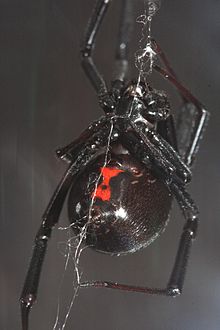| Latrodectus hesperus | |
|---|---|

| |
| Latrodectus hesperus female | |
| Scientific classification | |
| Domain: | Eukaryota |
| Kingdom: | Animalia |
| Phylum: | Arthropoda |
| Subphylum: | Chelicerata |
| Class: | Arachnida |
| Order: | Araneae |
| Infraorder: | Araneomorphae |
| Family: | Theridiidae |
| Genus: | Latrodectus |
| Species: | L. hesperus
|
| Binomial name | |
| Latrodectus hesperus | |
Latrodectus hesperus, the western black widow spider or western widow, is a venomous spider species found in western regions of North America. The female's body is 14–16 mm (1/2 in) in length and is black, often with an hourglass-shaped red mark on the lower abdomen. This "hourglass" mark can be yellow, and on rare occasions, white. The male of the species is around half this length and generally a tan color with lighter striping on the abdomen. The population was previously described as a subspecies of Latrodectus mactans and it is closely related to the northern species Latrodectus variolus. The species, as with others of the genus, build irregular or "messy" webs: unlike the spiral webs or the tunnel-shaped webs of other spiders, the strands of a Latrodectus web have no apparent organization.
Female black widows have potent venom containing a neurotoxin active against a range of mammals (see latrodectism). In humans, symptoms of this venom include pain, nausea, goosebumps, and localized sweating. In historical literature, fatalities were reported at anywhere between 0.5% and 12%,[2] but studies within the past several decades have been unable to confirm any fatalities from this or any of the other U.S. species of Latrodectus (e.g. zero fatalities among 23,409 documented Latrodectus bites from 2000 through 2008).[3] The female's consumption of the male after courtship, a cannibalistic and suicidal behavior observed in Latrodectus hasseltii (Australia's redback),[4] is rare in this species. Male western widows may breed several times during their relatively short lifespans.[5] Males are known to show preference for mating with well-fed females over starved ones, taking cues from the females' webs.[6]
- ^ Cite error: The named reference
WSC_s39049was invoked but never defined (see the help page). - ^ Bettini, S. (1964). Epidemiology of latrodectism. Toxicon, 2(2), 93–102
- ^ Monte AA, Bucher-Bartelson B, Heard KJ (2011) A US perspective of symptomatic Latrodectus spp. envenomation and treatment: a National Poison Data System review. Annals of Pharmacotherapy 45(12):1491-8. doi: 10.1345/aph.1Q424
- ^ Andrade, Maydianne C. B. (5 January 1996). "Sexual Selection for Male Sacrifice in the Australian Redback Spider". Science. 271 (5245): 70–2. Bibcode:1996Sci...271...70A. doi:10.1126/science.271.5245.70. S2CID 56279494. Retrieved 2007-01-15.
- ^ "Black Widow Spiders". Hastings Reserve. Archived from the original on 2009-08-08. Retrieved 2009-07-07.
- ^ Johnson, J. Chadwick; Trubl, Patricia Trubl; Blackmore, Valerie; Miles, Lindsay (2011). "Male black widows court well-fed females more than starved females: silken cues indicate sexual cannibalism risk". Animal Behaviour. 82 (2): 383–390. doi:10.1016/j.anbehav.2011.05.018. S2CID 53167419.